
A doughnut or donut is a type of food made from leavened fried dough. It is popular in many countries and is prepared in various forms as a sweet snack that can be homemade or purchased in bakeries, supermarkets, food stalls, and franchised specialty vendors. Doughnut is the traditional spelling, while donut is the simplified version; the terms are used interchangeably.

Beignet is a type of fritter, or deep-fried pastry, usually made from yeast dough in France, possibly made from pâte à choux and called Pets-de-nonne, nun's fart, in France, but may also be made from other types of dough, including yeast dough. In France there are many different versions of them, at least 20. They can vary in shape, the flour used for the dough, and the filling. It is popular in French, Italian, and French-American cuisines.

A zeppola is an Italian pastry consisting of a deep-fried dough ball of varying size but typically about 4 inches (10 cm) in diameter. This fritter is usually topped with powdered sugar, and may be filled with custard, jelly, cannoli-style pastry cream, or a butter-and-honey mixture. The consistency ranges from light and puffy, to bread- or pasta-like. It is eaten to celebrate Saint Joseph's Day, which is a Catholic feast day.
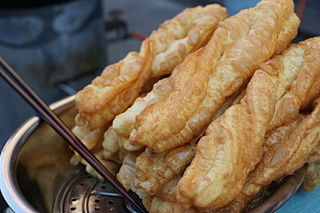
Youtiao, known in Southern China as Yu Char Kway is a long golden-brown deep-fried strip of dough of Chinese origin and also popular in other East and Southeast Asian cuisines.
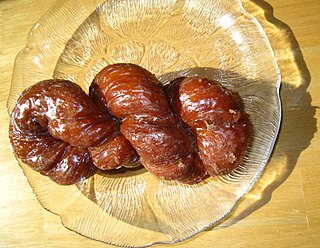
A cruller is a deep-fried pastry like a doughnut popular in Europe and North America often made from a rectangle of dough with a cut made in the middle that allows it to be pulled over and through itself, producing twists in the sides of the pastry. The cruller has been described as resembling "a small, braided torpedo". Some other cruller styles are made of a denser dough somewhat like that of a cake doughnut formed in a small loaf or stick shape, but not always twisted. Crullers may be topped with powdered sugar or icing.

Fried dough is a North American food associated with outdoor food stands in carnivals, amusement parks, fairs, rodeos, and seaside resorts. "Fried dough" is the specific name for a particular variety of fried bread made of a yeast dough; see the accompanying images for an example of use on carnival-booth signs. Fried dough is also known as fry dough, fry bread (bannock), fried bread, doughboys, elephant ears, beaver tails, scones, pizza fritte, frying saucers, and buñuelos. These foods are virtually identical to each other and some yeast dough versions of beignets, and recognizably different from other fried dough foods such as doughnuts or fritters.
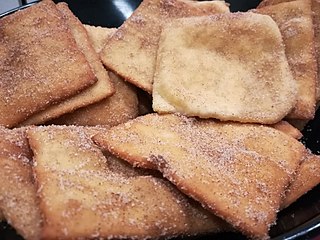
A sopaipilla, sopapilla, sopaipa, or cachanga is a kind of fried pastry and a type of quick bread served in several regions with Spanish heritage in the Americas. The word sopaipilla is the diminutive of sopaipa, a word that entered Spanish from the Mozarabic language of Al-Andalus. The original Mozarabic word Xopaipa was used to mean bread soaked in oil. The word is derived in turn from the Germanic word suppa, which meant bread soaked in liquid.

Choux pastry, or pâte à choux, is a delicate pastry dough used in many pastries. Basic ingredients usually only include butter, water, flour and eggs.

A Berliner is a German doughnut with no central hole, made from sweet yeast dough fried in fat or oil, with a marmalade or jam filling like a jelly doughnut, and usually icing, powdered sugar or conventional sugar on top.

Kreplach are small dumplings filled with ground meat, mashed potatoes or another filling, usually boiled and served in chicken soup, though they may also be served fried. They are similar to Polish and Ukrainian uszka, Russian pelmeni, Italian ravioli or tortellini, German Maultaschen, and Chinese jiaozi and wonton. The dough is traditionally made of flour, water and eggs, kneaded and rolled out thin. Some modern-day cooks use frozen dough sheets or wonton wrappers. Ready-made kreplach are also sold in the kosher freezer section of supermarkets.
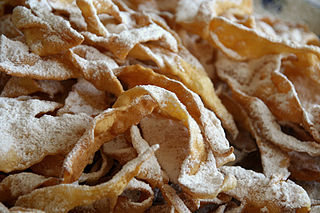
Angel wings are a traditional sweet crisp pastry made out of dough that has been shaped into thin twisted ribbons, deep-fried and sprinkled with powdered sugar. Common to many European cuisines, angel wings have been incorporated into other regional cuisines by immigrant populations. They are most commonly eaten in the period just before Lent, often during Carnival and on Fat Thursday, the last Thursday before Lent – not to be confused with "Fat Tuesday", the day before the start of Lent. There is a tradition in some countries for husbands to give angel wings to their wives on Friday the 13th in order to avoid bad luck.

Gosh-e fil is a fried pastry from Iranian cuisine and also popular in Afghanistan. The dough is shaped like an elephant ear (goosh), and deep-fried in oil. Each piece is then topped with chopped pistachios and powdered sugar.
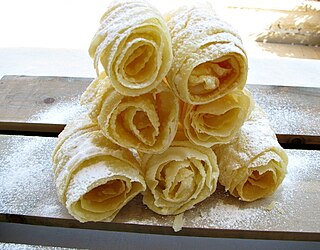
Fazuelos, fijuelas, hiuelas, deblas, or orecchie di Ammon are Sephardic Jewish pastries of thin fried dough. In Sephardic tradition, they are eaten at Purim; the Italian name recalls the shape of Haman's ears, similarly to the Hebrew name for hamantashen, oznei Haman.
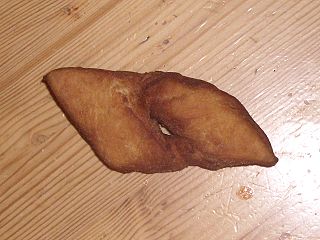
Klenät, kleinur, klena, klejne, kleina, kleyna, and fattigmann are all names for Angel wings, a fried pastry common in the Nordic countries as well as the rest of Europe and the United States. In nearby countries and Eastern European countries. The name is related to klen, the Swedish term for "slender", but is originally of Low German origin, which may indicate that the pastry was originally German. It is made from flattened dough cut into small trapezoids. A slit is cut in the middle and then one or both ends pulled through the slit to form a "knot". The kleina is then deep-fried in oil or another kind of fat. Subsequently can be sprinkled with powdered sugar and cinnamon.

Knieküchle is a traditional Austrian/German fried dough pastry that is very popular in Old Bavaria, Franconia, Western Austria, South Tyrol and Thuringia. Depending on region it has several other names, including Auszogne, Krapfen, Küchl, Nudel or Rottnudel. In Austria its name is Bauernkrapfen or Kiachl.

Paratha is a flatbread native to South Asia, prevalent throughout the modern-day nations of India, Sri Lanka, Pakistan, Nepal, Bangladesh, Maldives, Afghanistan, Myanmar, Malaysia, Singapore, Mauritius, Fiji, Guyana, Suriname, and Trinidad and Tobago where wheat is the traditional staple. Paratha is an amalgamation of the words parat and atta, which literally means layers of cooked dough. Alternative spellings and names include parantha, parauntha, prontha, parontay, paronthi (Punjabi), porota, paratha, palata, porotha, forota, farata, roti canai, prata, paratha, buss-up shut, oil roti.

Zalabiyeh or Pitulici is a fritter or doughnut found in several cuisines across Europe, the Middle East and West Asia. The fritter version is made from a semi-thin batter of wheat flour which is poured into hot oil and deep-fried. The earliest known recipe for the dish comes from a 10th-century Arabic cookbook and was originally made by pouring the batter through a coconut shell. Zalabiyeh is also the Arabic language term used by Mizrahi Jews for a deep-fried yeast dough, often topped with either honey or syrup, and known as burmuelos in Ladino.
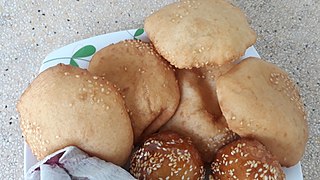
Ham chim peng, also spelt hum chim peng, known in Singapore and Malaysia as haam ji peng, hum ji peng, or ham ji peng, is a deep-fried hollow doughnut of Chinese origin. Commonly eaten as a breakfast food, it is sometimes fried with a coating of sesame seeds.


















